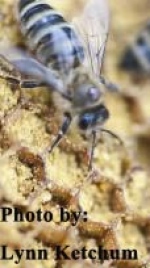 As the worldwide population of honey bees continues to decline, the Oregon State University Extension Service and partners have updated a tool for Pacific Northwest growers and beekeepers to reduce the impacts of pesticides on bees. As the worldwide population of honey bees continues to decline, the Oregon State University Extension Service and partners have updated a tool for Pacific Northwest growers and beekeepers to reduce the impacts of pesticides on bees.
The revision of OSU Extension's publication appears after an estimated 50,000 bumble bees died in a Wilsonville parking lot in June. The Oregon Department of Agriculture confirmed in a June 21 statement that the bee deaths were directly related to a pesticide application on linden trees conducted to control aphids. The episode prompted the ODA to issue a six-month restriction on 18 insecticides containing the active ingredient dinotefuran.
OSU researchers are investigating the effects of broad-spectrum neonicotinoids, such as dinotefuran, on native bees. The work is in progress, according to Ramesh Sagili, an OSU honeybee specialist.
The newly revised publication "How to Reduce Bee Poisoning from Pesticides" includes the latest research and regulations. Lead authors include Sagili and OSU toxicologist Louisa Hooven.
Download the updated version for free online at How to Reduce Bee Poisoning form Pesticides (pdf), using the link below.
See Attached files here:
|
